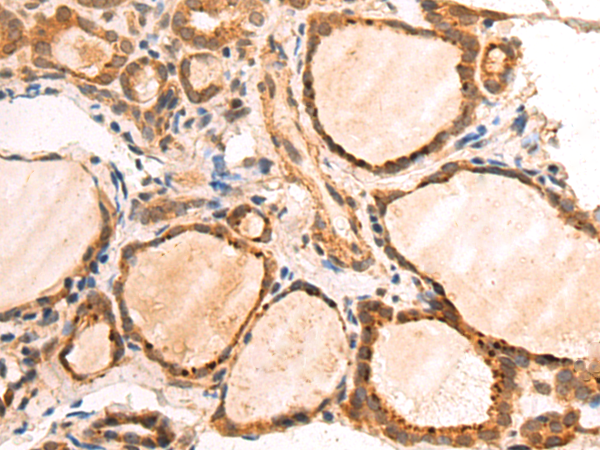


| WB | 咨询技术 | Human,Mouse,Rat |
| IF | 咨询技术 | Human,Mouse,Rat |
| IHC | 1/50-1/200 | Human,Mouse,Rat |
| ICC | 技术咨询 | Human,Mouse,Rat |
| FCM | 咨询技术 | Human,Mouse,Rat |
| Elisa | 1/5000-1/10000 | Human,Mouse,Rat |
| Aliases | HI95; SES2; SEST2 |
| WB Predicted band size | 54 kDa |
| Host/Isotype | Rabbit IgG |
| Antibody Type | Primary antibody |
| Storage | Store at 4°C short term. Aliquot and store at -20°C long term. Avoid freeze/thaw cycles. |
| Species Reactivity | Human, Mouse |
| Immunogen | Synthetic peptide of human SESN2 |
| Formulation | Purified antibody in PBS with 0.05% sodium azide and 50% glycerol. |
+ +
以下是3篇涉及SESN2(Sestrin2)抗体的代表性文献摘要示例:
---
1. **文献名称**:*SESN2 regulates AMPK signaling to modulate mitochondrial function in diabetic nephropathy*
**作者**:Kim, J. et al.
**摘要**:研究利用SESN2抗体检测糖尿病肾病模型中SESN2蛋白表达,发现其通过激活AMPK通路改善线粒体功能障碍,提示SESN2可能作为糖尿病肾病的治疗靶点。
---
2. **文献名称**:*Sestrin2 inhibits mTORC1 through interaction with GATOR2 in oxidative stress responses*
**作者**:Budanov, A.V. et al.
**摘要**:通过免疫沉淀(使用SESN2抗体)和功能实验,阐明SESN2在氧化应激中通过结合GATOR2复合物抑制mTORC1的分子机制,揭示了其细胞保护作用。
---
3. **文献名称**:*Sestrin2-dependent suppression of ferroptosis in Alzheimer's disease*
**作者**:Lee, S. et al.
**摘要**:利用SESN2抗体进行脑组织免疫组化分析,发现阿尔茨海默病模型中SESN2通过抑制铁死亡(ferroptosis)保护神经元,为神经退行性疾病提供新机制。
---
**备注**:以上文献信息为示例,实际引用需以具体论文为准。建议通过PubMed或Google Scholar检索关键词“Sestrin2 antibody”或“SESN2 application”获取最新研究。
The SESN2 (Sestrin2) antibody is a valuable tool in biomedical research, targeting the stress-inducible protein SESN2 involved in cellular stress responses and metabolic regulation. SESN2 belongs to the Sestrin family of evolutionarily conserved proteins that function as antioxidants and regulators of mTORC1 (mechanistic target of rapamycin complex 1) signaling. It is primarily activated under oxidative stress, DNA damage, or hypoxia via p53-dependent or independent pathways, playing a dual role in cytoprotection and tumor suppression. SESN2 modulates cellular homeostasis by inhibiting mTORC1 activity, thereby influencing autophagy, apoptosis, and metabolic reprogramming.
Antibodies against SESN2 are widely used to study its expression patterns, subcellular localization, and interactions in conditions like cancer, neurodegenerative diseases, and metabolic disorders. They enable detection via Western blotting, immunohistochemistry, and immunofluorescence, aiding in understanding SESN2's role in stress adaptation, aging, and disease progression. Research highlights SESN2's potential as a therapeutic target, particularly in cancers with dysregulated mTOR pathways or oxidative stress vulnerabilities. Both polyclonal and monoclonal SESN2 antibodies are available, with validation in specific experimental models critical for ensuring specificity. Ongoing studies focus on clarifying its pleiotropic functions, including links to inflammation, insulin resistance, and mitochondrial health, underscoring its relevance in translational medicine.
×